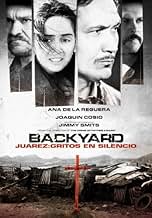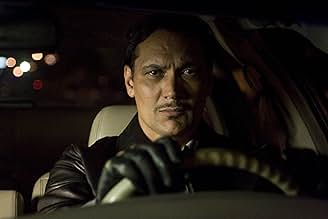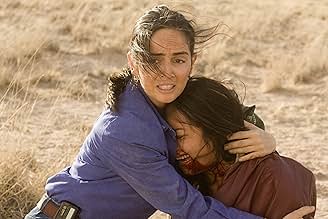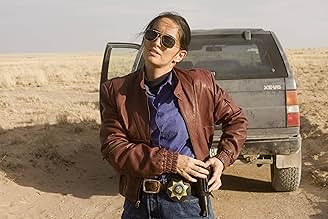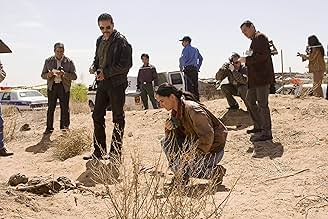El Traspatio
- 2009
- 2 h 2 min
AVALIAÇÃO DA IMDb
6,9/10
1,6 mil
SUA AVALIAÇÃO
Adicionar um enredo no seu idiomaThe true story of the border town of Juarez, Mexico where since the mid-1990s thousands of women have gone missing or turned up as sun-burnt corpses in the desert. Can new police captain Bla... Ler tudoThe true story of the border town of Juarez, Mexico where since the mid-1990s thousands of women have gone missing or turned up as sun-burnt corpses in the desert. Can new police captain Blanca Bravo stop the savagery?The true story of the border town of Juarez, Mexico where since the mid-1990s thousands of women have gone missing or turned up as sun-burnt corpses in the desert. Can new police captain Blanca Bravo stop the savagery?
- Prêmios
- 9 vitórias e 5 indicações no total
Avaliações em destaque
Before the explosion of drug cartel violence in Ciudad Juarez was the ongoing murders of hundreds of women, many of whose bodies were dumped in the surrounding desert. Police Detective Blanca (Ana De La Reguera) tries her best to get to the bottom of the murders but runs into resistance at every step, from her commander all the way to the state governor. Juarez was a magnet for women from the impoverished south of Mexico thanks to the opportunities there to work in the maquiladoras. Sara (Carolina Politi) is a young woman from Oaxaca who is among the thousands who come to Juarez seeking work, and in the process being changed by the new life there, where the old conservative traditions are often discarded. Through Sara the movie presents the tragedy of the killings in Juarez, as the boyfriend she jilts after a few dates is taken in by a group of men who persuade him to get even. We never know who does these killings, but the exploration of this gruesome phenomenon is nothing short of fascinating in its look into the attitudes towards these victims. The real star of the film is the city of Juarez itself, as a radio commentator describes the "cobalt sky" and the camera captures the city's outlying areas at near dark. Jimmy Smits plays a wealthy El Paso businessman who owns some of the bars in Juarez and who is revealed to be yet another prime suspect among the seemingly so many who may have played their own parts in these horrible crimes. In the end, the film makes you appreciate the tragedy of this city.
It's a fictionalized account of a long list of dead young women found in Juarez, Mexico during the 90s. They are all factory workers drawn to the new jobs. It's 1996. Police detective Blanca Bravo (Ana de la Reguera) is new and investigating the latest body found in the desert of Cuidad Juarez. The first documented case was 3 years ago and the police investigations have been incompetent. There is a lot of political and economical pressure to minimize the reality. The movie also follows Juanita who just arrived starting a new job at a factory. Bravo arrests a lowlife criminal and he calls businessman Mickey Santos (Jimmy Smits) for help. Santos is supposedly squeaky clean but he turns out to be a fellow sex offenders from El Paso. The governor is always pushing to put the case away.
I really like Ana de la Reguera. She's playing a smart cop in a world of compromises. She's carrying this movie on her shoulders. She adds another level by being a woman in a male dominated world. The setting is quite compelling. It's great to get the realistic locations. I do wish for better cinematography. However that's a small matter.
I really like Ana de la Reguera. She's playing a smart cop in a world of compromises. She's carrying this movie on her shoulders. She adds another level by being a woman in a male dominated world. The setting is quite compelling. It's great to get the realistic locations. I do wish for better cinematography. However that's a small matter.
BACKYARD is a gritty Mexican thriller that explores the plight of young women in the city of Ciudad Juarez. It's a film in which the rape and murder of these innocent figures plays a large part and thus it's largely unpalatable viewing, and yet as the whole thing is based on fact it's also extremely shocking.
Having experienced a few of these Mexican movies like the similar HELI I'm afraid to say that I'm not really a fan of them. I appreciate that the stories need to be told but I would much rather watch a documentary than a fictionalised version. BACKYARD is a hodge podge of all too familiar themes involving the drug trade, the problems faced by the police force seeking to bring those responsible to justice, corruption, exploitation, and of course human trafficking.
The story is rather overlong and does feel unfocused in places. It's never exciting or suspenseful, just rather depressing. Old-timer Jimmy Smits plays a local businessman and is cast well against type, giving a solid performance, but the rest of the cast seemed to me to be playing rather tired and predictable roles.
Having experienced a few of these Mexican movies like the similar HELI I'm afraid to say that I'm not really a fan of them. I appreciate that the stories need to be told but I would much rather watch a documentary than a fictionalised version. BACKYARD is a hodge podge of all too familiar themes involving the drug trade, the problems faced by the police force seeking to bring those responsible to justice, corruption, exploitation, and of course human trafficking.
The story is rather overlong and does feel unfocused in places. It's never exciting or suspenseful, just rather depressing. Old-timer Jimmy Smits plays a local businessman and is cast well against type, giving a solid performance, but the rest of the cast seemed to me to be playing rather tired and predictable roles.
One reviewer wrote that this movie is set in the "small" Mexican town of Ciudad Juarez, bordering the United States. Actually, Ciudad Juarez has approximately 1.3 million residents. While not the size of New York City or Los Angeles by any means, "small" town is hardly an appropriate description. FYI, Ciudad Juarez is only separated from El Paso, TX and a short stretch of Sunland Park/Anapra, NM by a narrow river, the Rio Grande (or Rio Bravo, as it is commonly known on the Mexican side). If seen from overhead it looks like one city. Many parts of Juarez are modern, Westernized-metro areas with shopping centers, U.S. fast-food chains, and an international airport. Together, the El Paso-Ciudad Juarez metropolitan area is populated by approximately 2.5 million people.
However, from Interstate 10 on the West Side of El Paso which parallels the river, the differences between the cities are quite evident. A typical U.S. metropolitan infrastructure can be seen on this side of the river, while shanty towns made of pallets and corrugated metal roofs can be seen on the other side. The sight is profound, sad, and all too real. When one grows up in an environment like that, one tends to have a different perspective of the U.S. and what "first world" really means. Most U.S. citizens don't ever confront those issues first hand, on a regular basis. We Southern Border Folk are exposed, directly or indirectly to a poverty that is severe, harsh, and very different from what U.S. poverty is typically known to be.
That severe poverty crosses over into the more rural border regions of the U.S. which are classified by the U.S. government as "Colonias", which are areas of the U.S. without the typical U.S. infrastructure that most U.S. Citizens take for granted (like electricity, natural gas, or running water). When you live in these regions, raised in them, compassion to those dealing with and escaping from this poverty becomes a part of you. Physical and geographical distance from that reality makes the heart less compassionate and the brain less understanding. That's why i believe most of us U.S. citizens tend to think politically before thinking humanely when involving border issues. We're mainly exposed to the "third world" through television; not driving to work, or shopping for groceries, or going to school.
Now there is undoubtedly extreme poverty scattered throughout the United States. Many citizens of Native-American communities and reservations live far below the U.S. poverty level. Pockets of what can be considered "third world" poverty exist especially in various regions of the South and in Appalachia, for example. These are areas like the "Colonias" where infrastructure is not systematic, but self-sufficiently innovated and "out-of-code", "off-the-grid", and not in that cool, tech-savvy, environmentally-progressive way. The difference between those areas and the "Colonias", besides the general ethnic background of the people (the aforementioned areas tend to be primarily White-Americans {or Americans of European descent}, and African-Americans) is that the "Colonias" encompass a much larger and concentrated geographical area as well as a much larger population of impoverished citizens than those scattered throughout the rest of the U.S.
These "Colonias" which exist from Texas all the way to California, and whose populations all together make up a few million, are real. The vast majority are of Mexican descent, though of course there are also smaller percentages of White-Americans, African-Americans, and Central-Americans. Many are "illegal", though most are legal citizens born and raised in the United States. "Third world" poverty exists in these regions of the U.S., make no mistake. These people constantly strive to be self sufficient. They don't expect hand outs. They don't expect government programs to save them as the politicians often describe them. But they are stuck between survival and laws and codes. Sometimes laws and codes can prevent immediate survival. The corruption between the corporate and political partnerships between the U.S. and Mexico, the laws and codes regarding construction, and land ownership and/or distribution controls their access to clean drinking water and proper waste management. As these regions therefore have a population that makes little money, the public school systems that do manage to exist there suffer greatly and can't offer education that rivals the high earning and supposedly higher tax paying metropolitan areas of our country. These complex issues keep them from being able to sustain themselves, much less plan ahead and progress.
The Capital cities of Texas, New Mexico, Arizona, and California only throw pennies towards their Southern borders. The money stays near the Capitals, where the streets are paved and the schools have college prep courses and highly educated, and the highest paid teachers. It's hard not to view some of this oppression as systematic, as planned politics in order to keep a lack of "legal" control in a region in order to aid the criminal, corrupt entities to work in the shadows, with the citizens' eyes not focused on them because their eyes are fixed on the priority of daily survival. As these citizens continue to be ignored, their voices dismissed and their plight for survival repressed, the Southern border of the U.S. will continue to crumble, through an oppression that breeds desperation that will only feed social unrest and revolution. This corruption between the two governments creates a void of leadership which is then filled by the black market; by criminal entities that create for themselves an alternative to the severe poverty of the region. Those entities become wealthy, which then become exploitative, threatening, violent, and powerful. But the key word is wealthy, the alternative to poverty, which becomes tempting to those who are most desperate. As the two governments shake hands and exchange "legal" treaties, contracts, and money, they ostracize their constituencies, they're citizens, leaving them exposed to the "illegal" elements which are only to happy to embrace them.
Peace
However, from Interstate 10 on the West Side of El Paso which parallels the river, the differences between the cities are quite evident. A typical U.S. metropolitan infrastructure can be seen on this side of the river, while shanty towns made of pallets and corrugated metal roofs can be seen on the other side. The sight is profound, sad, and all too real. When one grows up in an environment like that, one tends to have a different perspective of the U.S. and what "first world" really means. Most U.S. citizens don't ever confront those issues first hand, on a regular basis. We Southern Border Folk are exposed, directly or indirectly to a poverty that is severe, harsh, and very different from what U.S. poverty is typically known to be.
That severe poverty crosses over into the more rural border regions of the U.S. which are classified by the U.S. government as "Colonias", which are areas of the U.S. without the typical U.S. infrastructure that most U.S. Citizens take for granted (like electricity, natural gas, or running water). When you live in these regions, raised in them, compassion to those dealing with and escaping from this poverty becomes a part of you. Physical and geographical distance from that reality makes the heart less compassionate and the brain less understanding. That's why i believe most of us U.S. citizens tend to think politically before thinking humanely when involving border issues. We're mainly exposed to the "third world" through television; not driving to work, or shopping for groceries, or going to school.
Now there is undoubtedly extreme poverty scattered throughout the United States. Many citizens of Native-American communities and reservations live far below the U.S. poverty level. Pockets of what can be considered "third world" poverty exist especially in various regions of the South and in Appalachia, for example. These are areas like the "Colonias" where infrastructure is not systematic, but self-sufficiently innovated and "out-of-code", "off-the-grid", and not in that cool, tech-savvy, environmentally-progressive way. The difference between those areas and the "Colonias", besides the general ethnic background of the people (the aforementioned areas tend to be primarily White-Americans {or Americans of European descent}, and African-Americans) is that the "Colonias" encompass a much larger and concentrated geographical area as well as a much larger population of impoverished citizens than those scattered throughout the rest of the U.S.
These "Colonias" which exist from Texas all the way to California, and whose populations all together make up a few million, are real. The vast majority are of Mexican descent, though of course there are also smaller percentages of White-Americans, African-Americans, and Central-Americans. Many are "illegal", though most are legal citizens born and raised in the United States. "Third world" poverty exists in these regions of the U.S., make no mistake. These people constantly strive to be self sufficient. They don't expect hand outs. They don't expect government programs to save them as the politicians often describe them. But they are stuck between survival and laws and codes. Sometimes laws and codes can prevent immediate survival. The corruption between the corporate and political partnerships between the U.S. and Mexico, the laws and codes regarding construction, and land ownership and/or distribution controls their access to clean drinking water and proper waste management. As these regions therefore have a population that makes little money, the public school systems that do manage to exist there suffer greatly and can't offer education that rivals the high earning and supposedly higher tax paying metropolitan areas of our country. These complex issues keep them from being able to sustain themselves, much less plan ahead and progress.
The Capital cities of Texas, New Mexico, Arizona, and California only throw pennies towards their Southern borders. The money stays near the Capitals, where the streets are paved and the schools have college prep courses and highly educated, and the highest paid teachers. It's hard not to view some of this oppression as systematic, as planned politics in order to keep a lack of "legal" control in a region in order to aid the criminal, corrupt entities to work in the shadows, with the citizens' eyes not focused on them because their eyes are fixed on the priority of daily survival. As these citizens continue to be ignored, their voices dismissed and their plight for survival repressed, the Southern border of the U.S. will continue to crumble, through an oppression that breeds desperation that will only feed social unrest and revolution. This corruption between the two governments creates a void of leadership which is then filled by the black market; by criminal entities that create for themselves an alternative to the severe poverty of the region. Those entities become wealthy, which then become exploitative, threatening, violent, and powerful. But the key word is wealthy, the alternative to poverty, which becomes tempting to those who are most desperate. As the two governments shake hands and exchange "legal" treaties, contracts, and money, they ostracize their constituencies, they're citizens, leaving them exposed to the "illegal" elements which are only to happy to embrace them.
Peace
Backyard is a fictionalised version of events that actually occurred in a small Mexican/American border known as Ciudad Juarez.
The film covers similar ground to The Virgin Of Juarez and the better known Bordertown. In Backyard, though, Director Carlos Carrrera attempts to take a grittier, more realistic approach to telling the story.
While it's hard to argue with Ana de la Reguera's performance, one can't help wondering if this film would have benefited from a heroine that didn't take makeup and modelling classes while attending police academy.
An important story told badly.
The film covers similar ground to The Virgin Of Juarez and the better known Bordertown. In Backyard, though, Director Carlos Carrrera attempts to take a grittier, more realistic approach to telling the story.
While it's hard to argue with Ana de la Reguera's performance, one can't help wondering if this film would have benefited from a heroine that didn't take makeup and modelling classes while attending police academy.
An important story told badly.
Você sabia?
- CuriosidadesA newspaper from Torreón, México reported that the cast and crew were followed, and to some degree bullied, by people while shooting on location in Ciudad Juárez, México. They even reported the robbery of equipment.
- Erros de gravaçãoIn the scenes located in Juarez Avenue, it can be seen "transborde" buses and a big led screen with publicity. Those were activated in late 2006. (The story occurs on 1996)
Principais escolhas
Faça login para avaliar e ver a lista de recomendações personalizadas
- How long is Backyard?Fornecido pela Alexa
Detalhes
Bilheteria
- Faturamento bruto mundial
- US$ 822.960
- Tempo de duração2 horas 2 minutos
- Cor
- Mixagem de som
- Proporção
- 2.35 : 1
Contribua para esta página
Sugerir uma alteração ou adicionar conteúdo ausente

Principal brecha
By what name was El Traspatio (2009) officially released in Canada in English?
Responda

